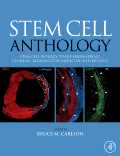|
|
|
| |
 |
|
|

|
 推薦指數:
推薦指數:





|
|
- 內容介紹
|
Stem Cell Anthology
From Stem Cell Biology, Tissue Engineering, Cloning, Regenerative Medicine and Biology
Bruce M. Carlson, MD, PhD
422 pages
Copyright 2010
Key Features
Includes a collection of chapters by leaders in the stem cell field including the first researchers to discover iPS cells and multiple Nobel Laureates
Provides the most detailed introduction to basic properties of major embryonic and adult stem cells by highlighting breakthrough discoveries in the nervous system, spinal cord, heart, pancreas, epidermis, musculo-skeletal, retina - leading areas of stem cell research in human application
Details technical laboratory set up for practitioners, technicians, and administrators
Description
The fields of stem cell research, regenerative medicine, tissue engineering, and cloning are very closely related. It is important for researchers in each of these disciplines to be aware of the methods and principles in the others. Elsevier publishes some of the highest individual references in these areas. Bringing together the principles, applications, and basic understanding in these related areas of science will provide a new reference which is serve the needs of a variety of researchers. Edited by Dr. Bruce Carlson, Stem Cell Anthology will be valuable to researchers and students who need to save time and link concepts to principles, applications, and methods in order to work more effectively and see links for potential collaborations.
Table of Contents
I. Introductory Chapters
Pluripotential stem cells from vertebrate embryos: Present perspective and future challenges (Gardner)
Postnatal stem cells (Gehron Robes and Bianco)
Adult epithelial tissue stem cells (Potten and Wilson)
Mesenchymal stem cells (Caplan)
Stem cells, plasticity and regeneration (Carlson)
II. Methods for Preparing Embryonic or Pluripotent Stem Cells
Setting up a facility for human embryonic stem cell research (Lyons, et.al.)
Approaches for derivation and maintenance of human embryonic stem cells: Detailed procedures and alternatives (Klimanskaya and MacMahon)
Derivation and differentiation of human embryonic germ cells (Gearhardt, et.al.)
Genetic manipulation of human embryonic stem cells (Mayshar and Benvenisty)
Induced pluripotential stem cell derivation (Yu and Thomspson)
III. Types and Properties of Stem Cells
Molecular basis of pluripotency (Cavaleri and Schöler)
Characteristics and characterization of human pluripotential stem cells (Bang and Carpenter)
Multipotent adult progenitor cells (Verfaillie and Crabbe)
Bone marrow stem cells: Properties and pluripotency (Xaymardan, et.al.)
Hematopoietic stem cell properties, markers, and therapeutics (Lindblad, et.al.)
Stem cells in the gastrointestinal tract (MacDonald, et.al.)
Stem cells derived from amniotic fluid and placenta (Atala, et.al.)
Nuclear transfer for stem cells (Trounson)
IV. Application of Stem Cell Biology to Regenerative Medicine
Neural stem cells for central nervous system repair (Gonzalez, et.al.)
Spinal cord injury (MacDonald and Becker)
Stem cells and heart disease (Leri, et.al.)
Cell-based repair for cardiovascular regeneration: What, why, how and where are we going in the next 5-10 years (Taylor and Zenovich)
Pancreatic stem cells (Dor and Melton)
Insulin-producing cells derived from stem cells: A potential treatment for diabetes (Benner-Weir and Weir)
Regeneration of epidermis from adult keratinocyte stem cells (Rochat and Barrandon)
Implantation of myogenic cells in skeletal muscles (Skuk and Trembley)
Cell-based therapies for musculoskeletal repair (Lee, et.al.)
Retinal pigment epithelium derived from embryonic stem cells (Klimanskaya)
|
|
|

